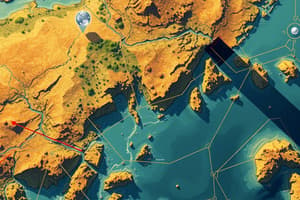Podcast
Questions and Answers
What is the main purpose of Control surveying?
What is the main purpose of Control surveying?
- To conduct cadastral surveying
- To establish monument reference points
- To create topographic maps
- To locate points for subsequent surveying operations (correct)
What is the key role of monuments in cadastral surveying?
What is the key role of monuments in cadastral surveying?
- Creating topographic maps
- Establishing property boundaries
- Providing legal rights for land ownership (correct)
- Determining environmental conditions
Why are monuments designed to be durable and permanent?
Why are monuments designed to be durable and permanent?
- To save costs in surveying operations
- To make them easier to move in case of errors
- To withstand environmental conditions and remain in place for an extended period (correct)
- To reduce the accuracy of survey measurements
What is the difference between a 'corner' and a 'monument' in surveying?
What is the difference between a 'corner' and a 'monument' in surveying?
What is a 'monument' in the context of public land survey?
What is a 'monument' in the context of public land survey?
Which statement best describes 'natural monuments'?
Which statement best describes 'natural monuments'?
What is the term for a monument that can be re-established with the help of other information?
What is the term for a monument that can be re-established with the help of other information?
How is an 'obliterated corner' defined in the context of public land survey?
How is an 'obliterated corner' defined in the context of public land survey?
In the public land survey, what is the definition of a 'lost corner'?
In the public land survey, what is the definition of a 'lost corner'?
What is a distinguishing feature between an 'obliterated corner' and a 'lost corner' as per the text?
What is a distinguishing feature between an 'obliterated corner' and a 'lost corner' as per the text?
A monument in surveying refers to a physical marker placed at a specific location on the ground.
A monument in surveying refers to a physical marker placed at a specific location on the ground.
Control surveying is not essential for accurate photogrammetry and topographic mapping.
Control surveying is not essential for accurate photogrammetry and topographic mapping.
The terms 'corner' and 'monument' can be used interchangeably in surveying.
The terms 'corner' and 'monument' can be used interchangeably in surveying.
Monuments in cadastral surveying serve as reference points for establishing property boundaries and land ownership.
Monuments in cadastral surveying serve as reference points for establishing property boundaries and land ownership.
Artificial monuments include natural features like rocks and trees.
Artificial monuments include natural features like rocks and trees.
A lost corner can be recovered beyond reasonable doubt.
A lost corner can be recovered beyond reasonable doubt.
A legal monument is controlling in the description.
A legal monument is controlling in the description.
If a monument's position can be established without doubts, it is considered obliterated.
If a monument's position can be established without doubts, it is considered obliterated.
Record monuments rely on a reference in a deed or description.
Record monuments rely on a reference in a deed or description.
An obliterated corner has no remaining traces of the monument at its point.
An obliterated corner has no remaining traces of the monument at its point.
Flashcards are hidden until you start studying



